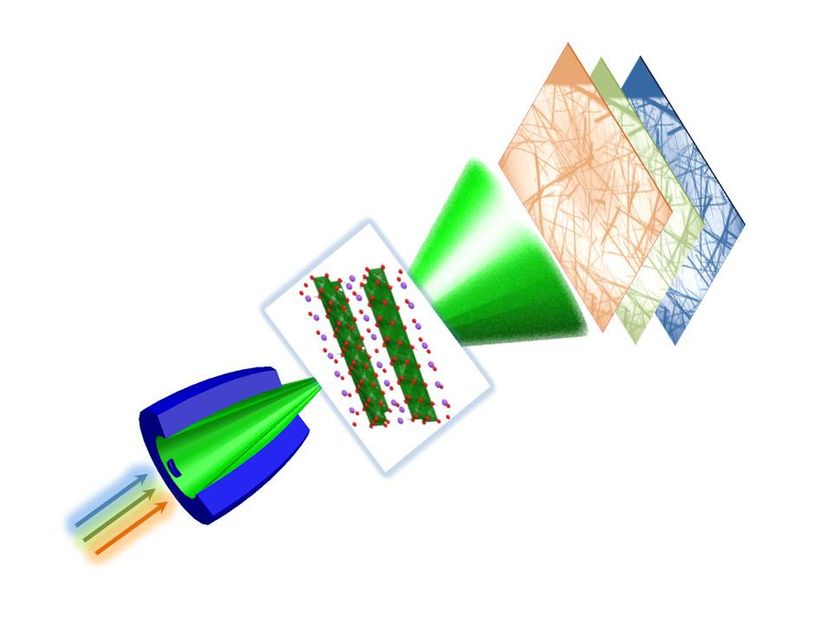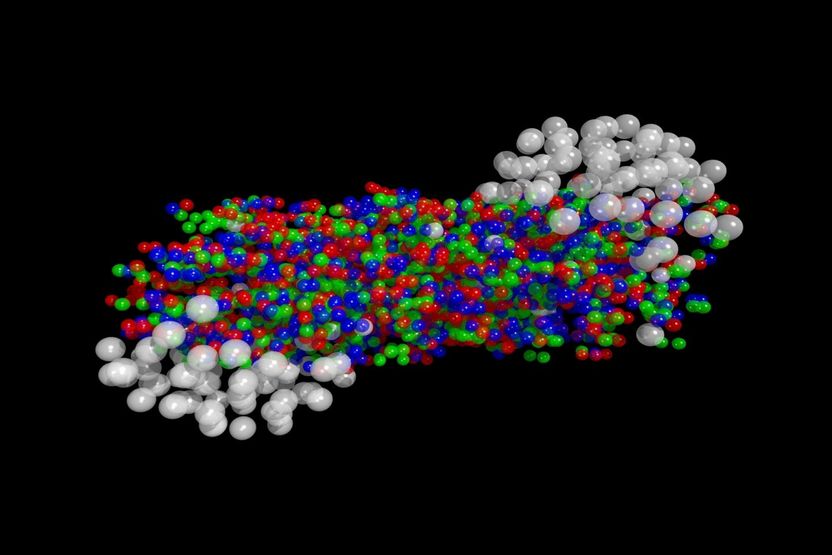Breakthrough in X-Ray Nanospectroscopy
HZB researchers achieve X-ray spectroscopy at nanoscale spatial resolution
Researchers at Helmholtz Zentrum Berlin (HZB) have developed a new microscope for high spatial resolution X-ray spectroscopic studies. While conventional x-ray spectroscopy has so far fallen short of resolving single nanoparticles, the X-ray microscope at HZB’s synchrotron source BESSY II succeeds by using high-brilliancy X-rays.

This picture schematically shows the studied titanium dioxide rods illuminated by X-rays of various photon energies through a capillary condenser. A high-resolution lens – not shown here – then forms an image of the objects.
HZB
Indeed, one of the essential reasons for studying nanoparticles or nanostructures is to determine their individual sizes and electronic properties. To attain the necessary spatial resolution, down to the nanoscale, the structures have to be illuminated with X-rays at high spectral resolution and imaged onto a detector using an X-ray lens. Dr. Peter Guttmann and the microscopy team of PD Dr. Gerd Schneider at the HZB Institute for Soft Matter and Functional Materials have published the new method in Nature Photonics.
There is great interest in the electronic properties of nanostructures, which can be functionalized in all kinds of ways, for example as active materials with a large surface area and small volume. Conceivable uses are in lithium-ion batteries, for example, or in photocatalysis to produce hydrogen as an energy carrier, or in solar cells. The HZB microscope is a new and attractive tool for materials sciences, and for energy research in particular.
This method can take pictures of nanoparticles inside object fields of up to 20 x 20 µm2 simultaneously with a CCD camera. An object field of this size holds many structures of interest. By recording image data in very small energy steps over a select energy range, the researchers obtain records of high-spatial-resolution images with spectral information. This provides a spectrum of each individual particle or portion of the nanostructure. These NEXAFS spectra, as they are called, reveal information about the electronic structure and ultimately the arrangement of the individual atoms within the nanoparticle. Unlike scanning X-ray microscopy, which measures sequentially the spectra of single nanoparticles with each picture, an image stack from the new method already contains the spectra of a large number of particles, meaning it already has statistical significance.
“An important advantage of our microscope is the time gain on top of the improved spectral resolution of 10,000,” says Dr. Peter Guttmann, physicist at HZB. “Unlike the scanning X-ray microscopes used so far for this, our microscope allow spectra to be recorded 100 times faster inside large object fields. We can use the HZB electron beam writer to produce advanced lenses that will improve our method from the current 25 nm to a spatial resolution of 10 nm.”
At the high spatial and spectral resolution of the microscope, the researchers cooperated with co-authors from Belgium, France and Slovenia to study the structure of specially built titanium dioxide nanorods. The nanorod studies they now present were done as a European cooperative as part of the COST action MP0901(NanoTP).
Other news from the department science
These products might interest you
Most read news
More news from our other portals
See the theme worlds for related content
Topic World Spectroscopy
Investigation with spectroscopy gives us unique insights into the composition and structure of materials. From UV-Vis spectroscopy to infrared and Raman spectroscopy to fluorescence and atomic absorption spectroscopy, spectroscopy offers us a wide range of analytical techniques to precisely characterize substances. Immerse yourself in the fascinating world of spectroscopy!

Topic World Spectroscopy
Investigation with spectroscopy gives us unique insights into the composition and structure of materials. From UV-Vis spectroscopy to infrared and Raman spectroscopy to fluorescence and atomic absorption spectroscopy, spectroscopy offers us a wide range of analytical techniques to precisely characterize substances. Immerse yourself in the fascinating world of spectroscopy!


































































